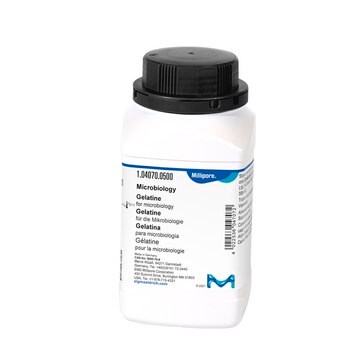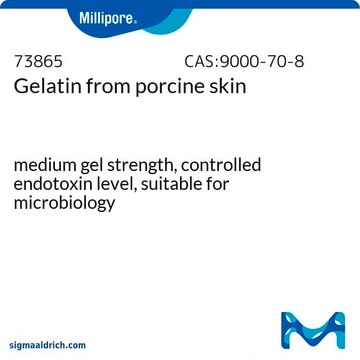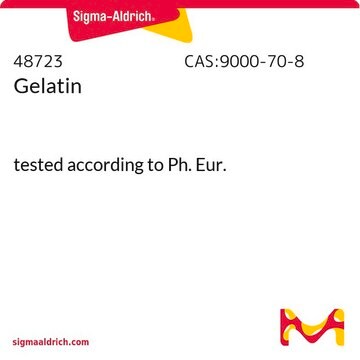39465
Gelatin from porcine skin
suitable for microbiology, ultrahigh gel strength
Sign Into View Organizational & Contract Pricing
All Photos(1)
About This Item
Recommended Products
biological source
Porcine
Quality Level
form
powder
quality
ultrahigh gel strength
shelf life
limited shelf life, expiry date on the label
loss
9.5-12.5% loss on drying
transmittance
450 nm, ≥85%
620 nm, ≥95%
pH
5.20-5.60
conductivity
120-190 μS/cm at 30 °C (1%)
viscosity
5.10-5.80 mPa.s
gel strength
280-302 g BloomAOAC
solubility
H2O: 67 mg/mL at 60 °C
cation traces
Ca: ≤100 mg/kg
application(s)
microbiology
Looking for similar products? Visit Product Comparison Guide
Related Categories
Application
This product is recommended for use as a cell culture substratum at 1-5 μg/cm2 or 0.5-50 μg/mL. The optimal concentration does depend on cell type as well as the application and research objectives.
Gelatin has been used in many applications. It has use in coating cell culture to improve attachment of cells, being added to PCR to stabilize Taq DNA, as a blocking reagent in Western blotting, ELISA, and immunochemistry, and as a component of media for species differentiation in bacteriology. As a biocompatible polymer, it has used as a delivery vehicle for release of active biomolecules and in generation of scaffolds for tissue engineering applications. In the pharmaceutical industry, geltan can be used as a suspending and encapsulating agent, among other applications.
Gelatin has been used in many applications. It has use in coating cell culture to improve attachment of cells, being added to PCR to stabilize Taq DNA, as a blocking reagent in Western blotting, ELISA, and immunochemistry, and as a component of media for species differentiation in bacteriology. As a biocompatible polymer, it has used as a delivery vehicle for release of active biomolecules and in generation of scaffolds for tissue engineering applications. In the pharmaceutical industry, geltan can be used as a suspending and encapsulating agent, among other applications.
Components
Gelatin is a heterogeneous mixture of water-soluble proteins of high average molecular masses, present in collagen. Proteins are extracted by boiling the relevant skin, tendons, ligaments, bones, etc. in water. Type A gelatin is derived from acid-cured tissue. Type B is derived from lime-cured tissue.
Caution
Dry gelatin, when stored in airtight containers at room temperature, will remain unchanged for many years. When heated at 100°C in the presence of air, it swells becomes soft and disintegrates to a carbonaceous mass with evolution of pyridine bases and ammonia.
Preparation Note
This product is derived from porcine skin. Gelatin is soluble in hot than in cold water. It is practically insoluble in most organic solvents such as alcohol, chloroform, carbon disulfide, carbon tetrachloride, ether, benzene, acetone, and oils. The Bloom number, determined by the Bloom gelometer, is an indication of the strength of a gel formed from a solution of the known concentrat ion. The Bloom number is proportional to the average molecular mass. Bloom numbers of porcine skin Gelatin vary from 90 to 300 g. Manufactured by Gelita AG
Storage Class Code
11 - Combustible Solids
WGK
nwg
Flash Point(F)
Not applicable
Flash Point(C)
Not applicable
Choose from one of the most recent versions:
Already Own This Product?
Find documentation for the products that you have recently purchased in the Document Library.
Customers Also Viewed
Johno Breeze et al.
Journal of the Royal Army Medical Corps, 159(2), 84-89 (2013-05-31)
Ballistic gelatin is the most common tissue simulant used to reproduce the penetration of projectiles into muscle but published data to support its use are primarily based on bullets, despite explosive fragments being the most common cause of injury to
M V Nasekin et al.
Anesteziologiia i reanimatologiia, (1)(1), 59-60 (2013-07-03)
The article deals with skills improving problem of epidural anaesthesia with ultrasound control. Methods of gelatin spinal column model making, use and its economical side are discussed in the article.
Ivy Kanungo et al.
Materials science & engineering. C, Materials for biological applications, 33(4), 2455-2459 (2013-03-19)
The dielectric behavior of the gelatine-GAGs based blend systems has been studied to understand the dynamic behavior of the water at the protein-GAGs interfaces which are relevant for tissue engineering application. Impedance (Z) and phase have been measured as a
Ashley R Flory et al.
BMC biotechnology, 13, 28-28 (2013-03-28)
It is important for industries to find green chemistries for manufacturing their products that have utility, are cost-effective and that protect the environment. The paper industry is no exception. Renewable resources derived from plant components could be an excellent substitute
Anish Babu et al.
Journal of biomedical nanotechnology, 9(2), 177-192 (2013-05-01)
The present study focused on the development of a novel biodegradable nanoparticle system based on polyethyleneglycol-modified gelatin (PEG-GEL) and polylactic acid (PLA) biopolymers for improving the photodynamic efficacy of cyclohexane-1,2-diamino hypocrellin B (CHA2HB), a potent photodynamic therapeutic (PDT) agent. The
Our team of scientists has experience in all areas of research including Life Science, Material Science, Chemical Synthesis, Chromatography, Analytical and many others.
Contact Technical Service















